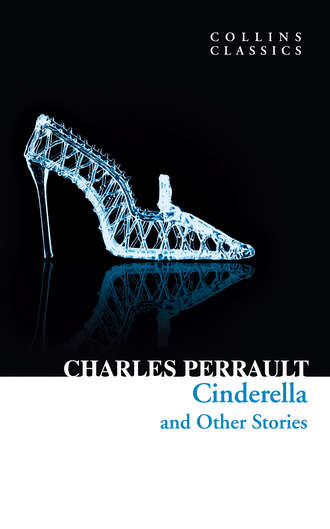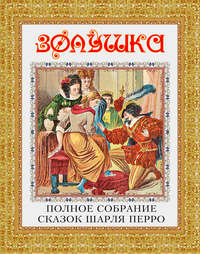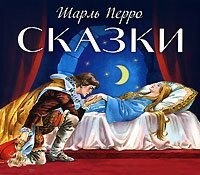
Полная версия
Cinderella and Other Stories

CINDERELLA AND OTHER STORIES
Charles Perrault
Translated by A. E. Johnson

Copyright
William Collins
An imprint of HarperCollinsPublishers
1 London Bridge Street,
London SE1 9GF
WilliamCollinsBooks.com
This eBook edition published by William Collins in 2015
Life & Times section © HarperCollinsPublishers Ltd
Silvia Crompton asserts her moral right as author of the Life & Times section
Classic Literature: Words and Phrases adapted from
Collins English Dictionary
Cover by e-Digital Design
Cover image: Glass slipper © R-O-M-A / Shutterstock
A catalogue record for this book is available from the British Library
All rights reserved under International and Pan-American Copyright Conventions. By payment of the required fees, you have been granted the non-exclusive, non-transferable right to access and read the text of this e-book on-screen. No part of this text may be reproduced, transmitted, down-loaded, decompiled, reverse engineered, or stored in or introduced into any information storage and retrieval system, in any form or by any means, whether electronic or mechanical, now known or hereinafter invented, without the express written permission of HarperCollins
Source ISBN: 9780008147457
Ebook Edition © August 2015 ISBN: 9780008147464
Version: 2015-07-21
CONTENTS
Cover
Title Page
Copyright
History of Collins
Life & Times
The Sleeping Beauty in the Wood
Puss in Boots
Little Tom Thumb
The Fairies
Ricky of the Tuft
Cinderella, or the Little Glass Slipper
Little Red Riding Hood
Blue Beard
The Ridiculous Wishes
Donkey-Skin
Classic Literature: Words and Phrases
About the Publisher
History of Collins
In 1819, millworker William Collins from Glasgow, Scotland, set up a company for printing and publishing pamphlets, sermons, hymn books, and prayer books. That company was Collins and was to mark the birth of HarperCollins Publishers as we know it today. The long tradition of Collins dictionary publishing can be traced back to the first dictionary William published in 1824, Greek and English Lexicon. Indeed, from 1840 onwards, he began to produce illustrated dictionaries and even obtained a licence to print and publish the Bible.
Soon after, William published the first Collins novel, Ready Reckoner; however, it was the time of the Long Depression, where harvests were poor, prices were high, potato crops had failed, and violence was erupting in Europe. As a result, many factories across the country were forced to close down and William chose to retire in 1846, partly due to the hardships he was facing.
Aged 30, William’s son, William II, took over the business. A keen humanitarian with a warm heart and a generous spirit, William II was truly ‘Victorian’ in his outlook. He introduced new, up-to-date steam presses and published affordable editions of Shakespeare’s works and The Pilgrim’s Progress, making them available to the masses for the first time. A new demand for educational books meant that success came with the publication of travel books, scientific books, encyclopedias, and dictionaries. This demand to be educated led to the later publication of atlases, and Collins also held the monopoly on scripture writing at the time.
In the 1860s Collins began to expand and diversify and the idea of ‘books for the millions’ was developed. Affordable editions of classical literature were published, and in 1903 Collins introduced 10 titles in their Collins Handy Illustrated Pocket Novels. These proved so popular that a few years later this had increased to an output of 50 volumes, selling nearly half a million in their year of publication. In the same year, The Everyman’s Library was also instituted, with the idea of publishing an affordable library of the most important classical works, biographies, religious and philosophical treatments, plays, poems, travel, and adventure. This series eclipsed all competition at the time, and the introduction of paperback books in the 1950s helped to open that market and marked a high point in the industry.
HarperCollins is and has always been a champion of the classics, and the current Collins Classics series follows in this tradition – publishing classical literature that is affordable and available to all. Beautifully packaged, highly collectible, and intended to be reread and enjoyed at every opportunity.
Life & Times
Cinderella and Other Stories
The fairy tales we all grew up with are so familiar to us that it is hard to imagine someone, somewhere, having sat down and actually written them. Perhaps thanks to their modern-day Hollywood adaptations, we barely think of them as books at all. But although tales similar to Cinderella, Sleeping Beauty and Puss in Boots have existed in European oral storytelling traditions for centuries, it took one man, very late in his life, to update them for the modern age and record them for posterity. That man was Charles Perrault.
An Auspicious Start
There is relatively little to be said about Charles Perrault’s early years, perhaps because he had a considerably more fortunate childhood than most famous writers. Perrault was born in Paris in 1628, the fifth son of wealthy parents. He was sent to a prestigious school and did well there, becoming, in his own words, ‘one of the best students in my class’. ‘I took so much pleasure in class debates,’ he later recalled in his memoirs, ‘that I enjoyed the days we went to school as much as the holidays.’ Around the age of fifteen, he left school to study independently for a few years — among other subjects, poetry — during which he also found the time to put together a burlesque translation of a portion of Virgil’s Aeneid.
But writing was not the career he — or, more to the point, his father — had in mind. Aged twenty-three, and after a fleeting attendance at the University of Orléans (‘They were not … strict … in granting degrees’), Perrault became a lawyer. It was a short-lived endeavour and he never settled into it, abandoning the profession in 1654 to become a government clerk under his brother Pierre. Finding his new job ‘not very demanding’, Perrault took to visiting libraries and reading poetry, and was inspired to write a poem, ‘Le Portrait d’Iris’, which was published to positive reviews in 1659.
Although he continued to write and publish poetry, he spent the late 1650s and early 1660s restoring and redesigning a large family estate, as a result of which he came to the attention of Jean-Baptiste Colbert, Louis XIV’s superintendent of buildings. Under Colbert’s patronage, Perrault rose to a position of significant influence in the royal court, even able to appoint his own brother Claude to design the east wing of the Louvre. He took to commemorating notable royal events in verse.
The Quarrel of the Ancients and the Moderns
By 1671, Perrault was esteemed enough in Parisian society to be elected to the prestigious Académie française, an elite authority established to maintain correct usage of the French language. In this role, he became deeply involved in an academic debate that began as a difference of artistic opinion and quickly developed into a fierce, decades-long war of words between France’s most eminent thinkers.
The subject of the debate sounds almost trivial now, but in the late seventeenth century it challenged the very foundations of the Académie française. It centred on a long-held view among academics that no contemporary writer could ever match the talent and excellence of his Classical Greek and Roman predecessors. Perrault was one of a few members who thought differently, and in 1674, after his less enlightened colleagues mounted a denunciation of opera — then a relatively new form of music — he published Critique de l’Opéra, a spirited defence that made unfavourable comparisons with ancient works.
The Académie quickly split into two factions, the Anciens (among them Nicolas Boileau, Jean Racine and Jean de la Fontaine) and the Modernes (led by Perrault), who took to publishing and counter-publishing tracts against the other’s thinking. Perrault’s Le Siècle de Louis le Grand (The Century of Louis the Great), published in 1687, was one of the key cases for the prosecution, establishing the Modernes’ arguably immodest viewpoint that they were living and writing in times of artistic excellence.
The debate continued into the early years of the eighteenth century but Perrault and his supporters ultimately won the day, setting the scene for France to lead the world in literary and artistic experimentation.
Fabulous Beasts
Perrault was briefly married in the 1670s, to Marie Guichon, a woman many decades his junior, and they had four children before she succumbed to an early death. During this period he was influential in advising Louis XIV on his plans for expansion at the Palace of Versailles; perhaps it was becoming a family man that compelled him to talk the king into adding thirty-nine elaborate fountains along the pathways of the Versailles labyrinth, each of them depicting one of Aesop’s fables. In a playful twist, the figures were designed to ‘converse’ with one another by shooting out alternating jets of water. It was an early indication of Perrault’s love of old folk tales and memorable characters, although he would not write his first collection until his own children were adults.
This last change in Perrault’s meandering career is once again attributable to the intervention of Jean-Baptiste Colbert, albeit in an indirect way. By the early 1680s Perrault seems to have fallen out of favour with his former patron, and he was gradually pushed aside to make way for Colbert’s son. Jobless, widowed, and with his children growing up fast, Perrault turned to writing. He was sixty-nine years old in 1697 when he published Histoires ou contes du temps passé or Les Contes de ma mère l’oye (Stories or Tales from Past Times or Tales of Mother Goose).
The tales were modernised, some of them significantly, from both well-known and more obscure European peasant tales as well as from ancient sources — a poke in the eye, it has been argued, to Perrault’s Ancien colleagues at the Académie française. The Ridiculous Wishes and Donkey-Skin were stories Perrault had been toying with for a number of years, although both are likely to have been based on folk tales and fables. A handful of the stories had previously appeared in print, notably the Cinderella and Sleeping Beauty of Giambattista Basile, published in Italy in the 1630s, but the additions and edits made by Perrault were substantial: he gave Cinderella her Fairy Godmother and glass slippers and spared Sleeping Beauty a sexual assault by the king she goes on to marry. He cut the ending in which Puss in Boots fakes his own death to see if he’ll get a golden coffin, and gave Little Red Riding Hood her red hood.
Curiously, Perrault published his collection under the name of his teenage son, Pierre Perrault Darmancour. Perhaps, aged almost seventy, and just six years before his death, Perrault was handing over the baton of literary modernism to the next generation.
Charles Perrault died in Paris in 1703. He could little have predicted the legacy of his late literary outpouring, or that many of his adaptations of fables and folk tales would become the definitive texts. Over a century later, when the Brothers Grimm mined European storytelling traditions for their own influential collection, Perrault’s contes were among the richest sources. If they made changes to his stories to better fit with their own time, one can only assume Perrault would have approved.
THE SLEEPING BEAUTY IN THE WOOD
Once upon a time there lived a king and queen who were grieved, more grieved than words can tell, because they had no children. They tried the waters of every country, made vows and pilgrimages, and did everything that could be done, but without result. At last, however, the queen found that her wishes were fulfilled, and in due course she gave birth to a daughter.
A grand christening was held, and all the fairies that could be found in the realm (they numbered seven in all) were invited to be godmothers to the little princess. This was done so that by means of the gifts which each in turn would bestow upon her (in accordance with the fairy custom of those days) the princess might be endowed with every imaginable perfection.
When the christening ceremony was over, all the company returned to the king’s palace, where a great banquet was held in honour of the fairies. Places were laid for them in magnificent style, and before each was placed a solid gold casket containing a spoon, fork, and knife of fine gold, set with diamonds and rubies. But just as all were sitting down to table an aged fairy was seen to enter, whom no one had thought to invite—the reason being that for more than fifty years she had never quitted the tower in which she lived, and people had supposed her to be dead or bewitched.
By the king’s orders a place was laid for her, but it was impossible to give her a golden casket like the others, for only seven had been made for the seven fairies. The old creature believed that she was intentionally slighted, and muttered threats between her teeth.
She was overheard by one of the young fairies, who was seated near by. The latter, guessing that some mischievous gift might be bestowed upon the little princess, hid behind the tapestry as soon as the company left the table. Her intention was to be the last to speak, and so to have the power of counteracting, as far as possible, any evil which the old fairy might do.
Presently the fairies began to bestow their gifts upon the princess. The youngest ordained that she should be the most beautiful person in the world; the next, that she should have the temper of an angel; the third, that she should do everything with wonderful grace; the fourth, that she should dance to perfection; the fifth, that she should sing like a nightingale; and the sixth, that she should play every kind of music with the utmost skill.
It was now the turn of the aged fairy. Shaking her head, in token of spite rather than of infirmity, she declared that the princess should prick her hand with a spindle, and die of it. A shudder ran through the company at this terrible gift. All eyes were filled with tears.
But at this moment the young fairy stepped forth from behind the tapestry.
‘Take comfort, your Majesties,’ she cried in a loud voice; ‘your daughter shall not die. My power, it is true, is not enough to undo all that my aged kinswoman has decreed: the princess will indeed prick her hand with a spindle. But instead of dying she shall merely fall into a profound slumber that will last a hundred years. At the end of that time a king’s son shall come to awaken her.’
The king, in an attempt to avert the unhappy doom pronounced by the old fairy, at once published an edict forbidding all persons, under pain of death, to use a spinning-wheel or keep a spindle in the house.
At the end of fifteen or sixteen years the king and queen happened one day to be away, on pleasure bent. The princess was running about the castle, and going upstairs from room to room she came at length to a garret at the top of a tower, where an old serving-woman sat alone with her distaff, spinning. This good woman had never heard speak of the king’s proclamation forbidding the use of spinning-wheels.
‘What are you doing, my good woman?’ asked the princess.
‘I am spinning, my pretty child,’ replied the dame, not knowing who she was.
‘Oh, what fun!’ rejoined the princess; ‘how do you do it? Let me try and see if I can do it equally well.’
Partly because she was too hasty, partly because she was a little heedless, but also because the fairy decree had ordained it, no sooner had she seized the spindle than she pricked her hand and fell down in a swoon.
In great alarm the good dame cried out for help. People came running from every quarter to the princess. They threw water on her face, chafed her with their hands, and rubbed her temples with the royal essence of Hungary. But nothing would restore her.
Then the king, who had been brought upstairs by the commotion, remembered the fairy prophecy. Feeling certain that what had happened was inevitable, since the fairies had decreed it, he gave orders that the princess should be placed in the finest apartment in the palace, upon a bed embroidered in gold and silver.
You would have thought her an angel, so fair was she to behold. The trance had not taken away the lovely colour of her complexion. Her cheeks were delicately flushed, her lips like coral. Her eyes, indeed, were closed, but her gentle breathing could be heard, and it was therefore plain that she was not dead. The king commanded that she should be left to sleep in peace until the hour of her awakening should come.
When the accident happened to the princess, the good fairy who had saved her life by condemning her to sleep a hundred years was in the kingdom of Mataquin, twelve thousand leagues away. She was instantly warned of it, however, by a little dwarf who had a pair of seven-league boots, which are boots that enable one to cover seven leagues at a single step. The fairy set off at once, and within an hour her chariot of fire, drawn by dragons, was seen approaching.
The king handed her down from her chariot, and she approved of all that he had done. But being gifted with great powers of foresight, she bethought herself that when the princess came to be awakened, she would be much distressed to find herself all alone in the old castle. And this is what she did.
She touched with her wand everybody (except the king and queen) who was in the castle—governesses, maids of honour, ladies-in-waiting, gentlemen, officers, stewards, cooks, scullions, errand boys, guards, porters, pages, footmen. She touched likewise all the horses in the stables, with their grooms, the big mastiffs in the courtyard, and little Puff, the pet dog of the princess, who was lying on the bed beside his mistress. The moment she had touched them they all fell asleep, to awaken only at the same moment as their mistress. Thus they would always be ready with their service whenever she should require it. The very spits before the fire, loaded with partridges and pheasants, subsided into slumber, and the fire as well. All was done in a moment, for the fairies do not take long over their work.
Then the king and queen kissed their dear child, without waking her, and left the castle. Proclamations were issued, forbidding any approach to it, but these warnings were not needed, for within a quarter of an hour there grew up all round the park so vast a quantity of trees big and small, with interlacing brambles and thorns, that neither man nor beast could penetrate them. The tops alone of the castle towers could be seen, and these only from a distance. Thus did the fairy’s magic contrive that the princess, during all the time of her slumber, should have nought whatever to fear from prying eyes.
At the end of a hundred years the throne had passed to another family from that of the sleeping princess. One day the king’s son chanced to go a-hunting that way, and seeing in the distance some towers in the midst of a large and dense forest, he asked what they were. His attendants told him in reply the various stories which they had heard. Some said there was an old castle haunted by ghosts, others that all the witches of the neighbourhood held their revels there. The favourite tale was that in the castle lived an ogre, who carried thither all the children whom he could catch. There he devoured them at his leisure, and since he was the only person who could force a passage through the wood nobody had been able to pursue him.
While the prince was wondering what to believe, an old peasant took up the tale.
‘Your Highness.’ said he, ‘more than fifty years ago I heard my father say that in this castle lies a princess, the most beautiful that has ever been seen. It is her doom to sleep there for a hundred years, and then to be awakened by a king’s son, for whose coming she waits.’
This story fired the young prince. He jumped immediately to the conclusion that it was for him to see so gay an adventure through, and impelled alike by the wish for love and glory, he resolved to set about it on the spot.
Hardly had he taken a step towards the wood when the tall trees, the brambles and the thorns, separated of themselves and made a path for him. He turned in the direction of the castle, and espied it at the end of a long avenue. This avenue he entered, and was surprised to notice that the trees closed up again as soon as he had passed, so that none of his retinue were able to follow him. A young and gallant prince is always brave, however; so he continued on his way, and presently reached a large fore-court.
The sight that now met his gaze was enough to fill him with an icy fear. The silence of the place was dreadful, and death seemed all about him. The recumbent figures of men and animals had all the appearance of being lifeless, until he perceived by the pimply noses and ruddy faces of the porters that they merely slept. It was plain, too, from their glasses, in which were still some dregs of wine, that they had fallen asleep while drinking.
The prince made his way into a great courtyard, paved with marble, and mounting the staircase entered the guardroom. Here the guards were lined up on either side in two ranks, their muskets on their shoulders, snoring their hardest. Through several apartments crowded with ladies and gentlemen in waiting, some seated, some standing, but all asleep, he pushed on, and so came at last to a chamber which was decked all over with gold. There he encountered the most beautiful sight he had ever seen. Reclining upon a bed, the curtains of which on every side were drawn back, was a princess of seemingly some fifteen or sixteen summers, whose radiant beauty had an almost unearthly lustre.
Trembling in his admiration he drew near and went on his knees beside her. At the same moment, the hour of disenchantment having come, the princess awoke, and bestowed upon him a look more tender than a first glance might seem to warrant.
‘Is it you, dear prince?’ she said; ‘you have been long in coming!’
Charmed by these words, and especially by the manner in which they were said, the prince scarcely knew how to express his delight and gratification. He declared that he loved her better than he loved himself. His words were faltering, but they pleased the more for that. The less there is of eloquence, the more there is of love.
Her embarrassment was less than his, and that is not to be wondered at, since she had had time to think of what she would say to him. It seems (although the story says nothing about it) that the good fairy had beguiled her long slumber with pleasant dreams. To be brief, after four hours of talking they had not succeeded in uttering one half of the things they had to say to each other.








